Report: Causes of Small Business Failure in International Markets
VerifiedAdded on 2020/02/24
|14
|3411
|50
Report
AI Summary
This report investigates the major causes of small business failures in international business, specifically focusing on Australia, Israel, and EU countries. The methodology section details the research approach, including the use of qualitative and quantitative methods, with a mixed methodology approach. The report outlines the data collection methods, including face-to-face and telephonic interviews, as well as questionnaires, and discusses the data analysis techniques. It also describes the sampling methods used, including probability sampling and stratified sampling. The report aims to identify the key factors contributing to business failures, considering financial capabilities, management abilities, external factors, and the role of innovation and creativity, and analyzes primary and secondary data to find the gap between them. The report also covers the ethical considerations and references used.
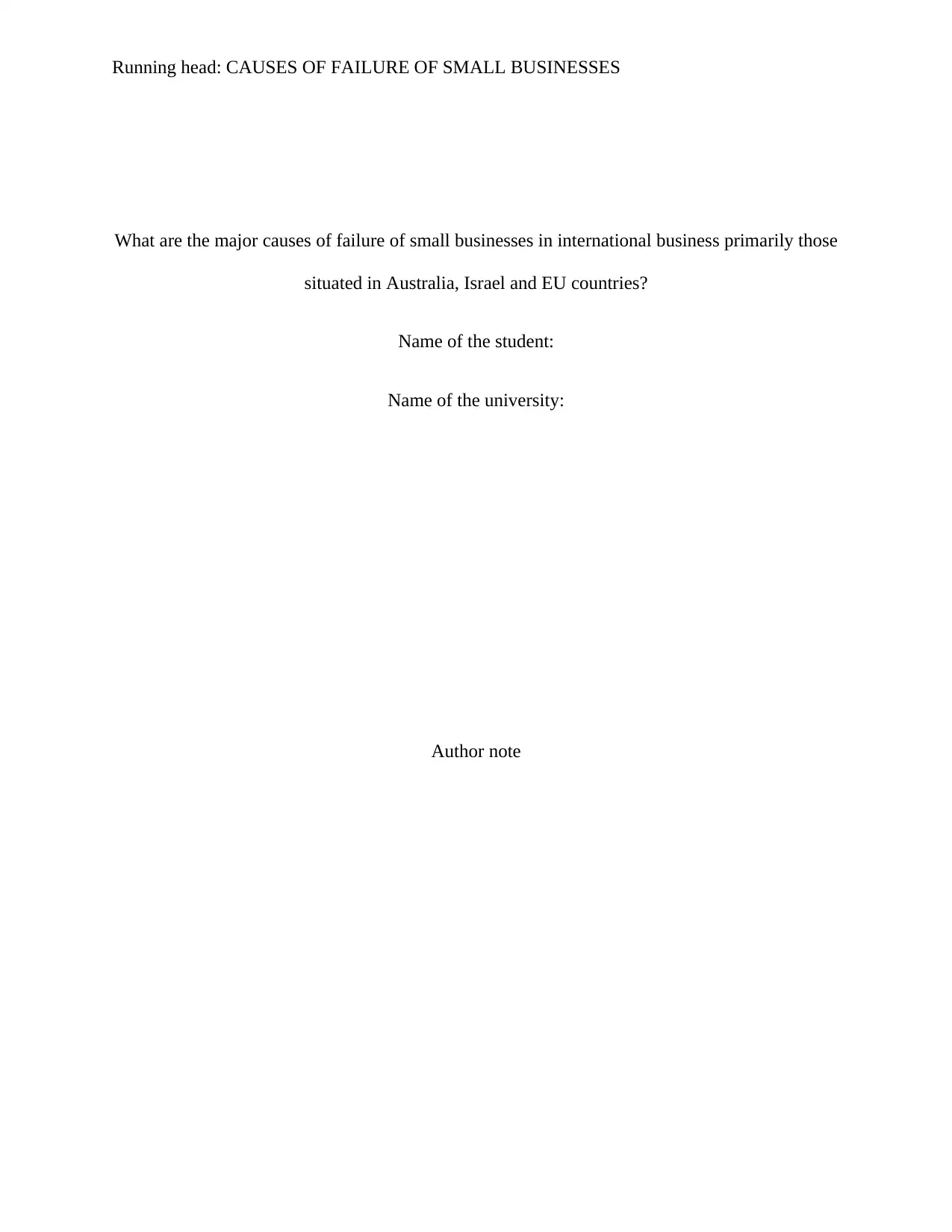
Running head: CAUSES OF FAILURE OF SMALL BUSINESSES
What are the major causes of failure of small businesses in international business primarily those
situated in Australia, Israel and EU countries?
Name of the student:
Name of the university:
Author note
What are the major causes of failure of small businesses in international business primarily those
situated in Australia, Israel and EU countries?
Name of the student:
Name of the university:
Author note
Paraphrase This Document
Need a fresh take? Get an instant paraphrase of this document with our AI Paraphraser
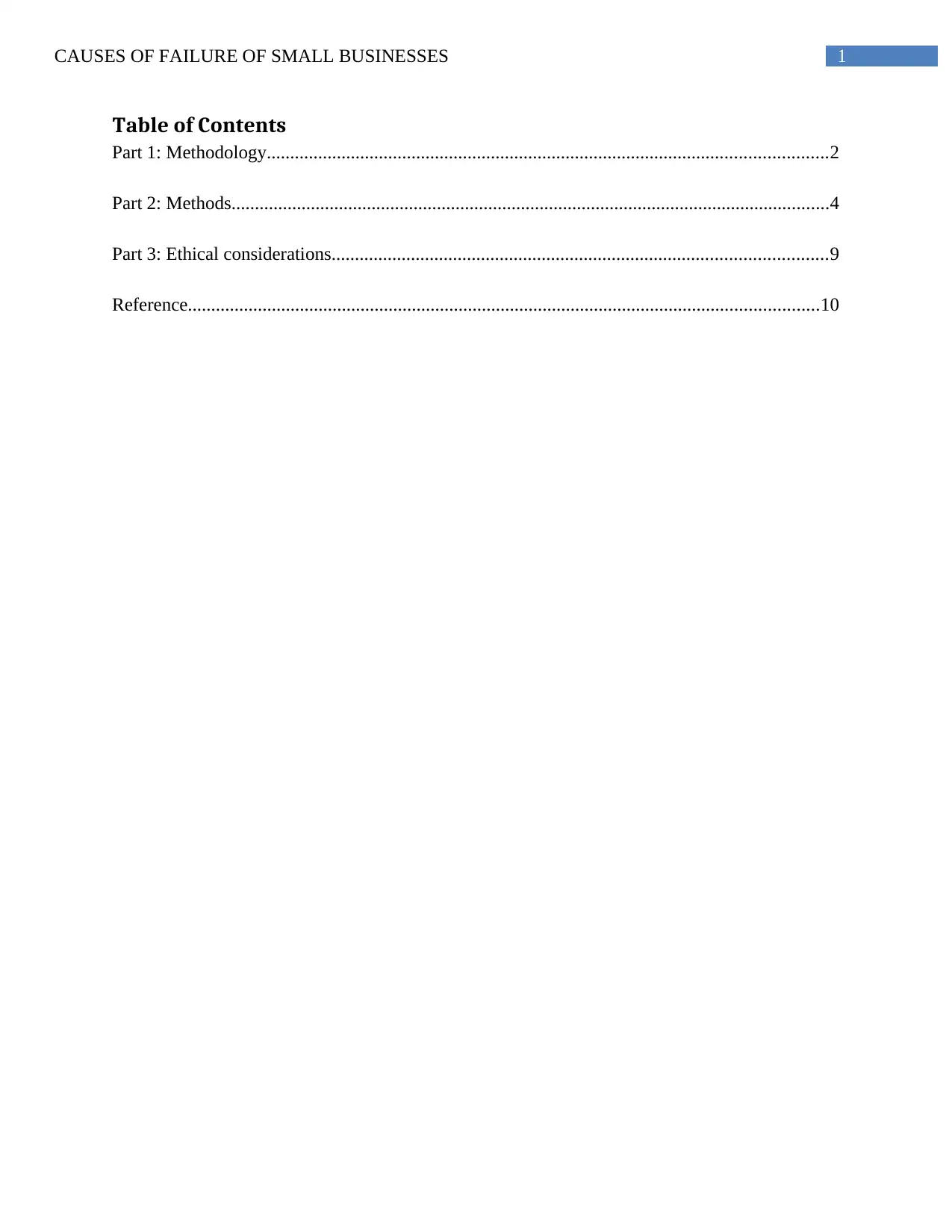
1CAUSES OF FAILURE OF SMALL BUSINESSES
Table of Contents
Part 1: Methodology........................................................................................................................2
Part 2: Methods................................................................................................................................4
Part 3: Ethical considerations..........................................................................................................9
Reference.......................................................................................................................................10
Table of Contents
Part 1: Methodology........................................................................................................................2
Part 2: Methods................................................................................................................................4
Part 3: Ethical considerations..........................................................................................................9
Reference.......................................................................................................................................10
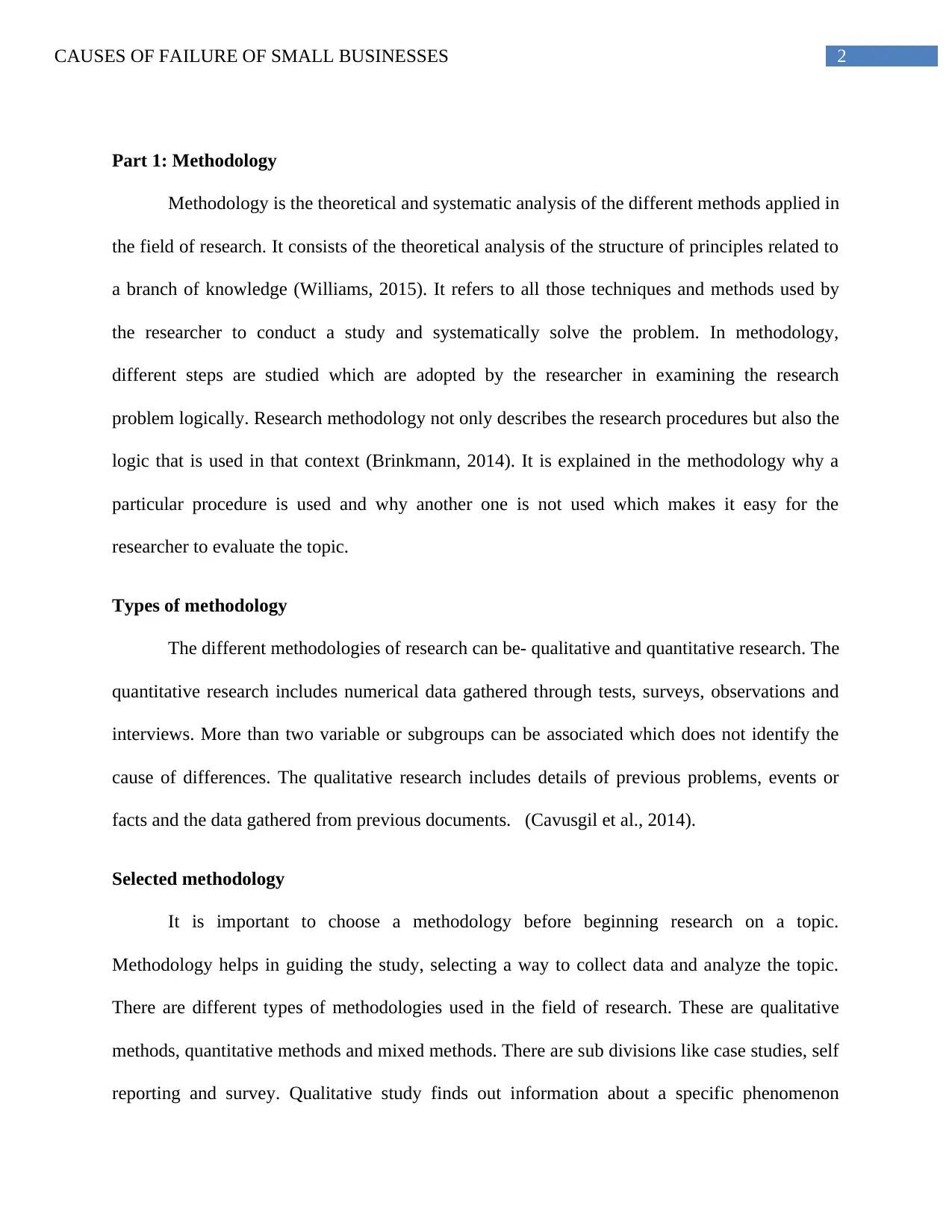
2CAUSES OF FAILURE OF SMALL BUSINESSES
Part 1: Methodology
Methodology is the theoretical and systematic analysis of the different methods applied in
the field of research. It consists of the theoretical analysis of the structure of principles related to
a branch of knowledge (Williams, 2015). It refers to all those techniques and methods used by
the researcher to conduct a study and systematically solve the problem. In methodology,
different steps are studied which are adopted by the researcher in examining the research
problem logically. Research methodology not only describes the research procedures but also the
logic that is used in that context (Brinkmann, 2014). It is explained in the methodology why a
particular procedure is used and why another one is not used which makes it easy for the
researcher to evaluate the topic.
Types of methodology
The different methodologies of research can be- qualitative and quantitative research. The
quantitative research includes numerical data gathered through tests, surveys, observations and
interviews. More than two variable or subgroups can be associated which does not identify the
cause of differences. The qualitative research includes details of previous problems, events or
facts and the data gathered from previous documents. (Cavusgil et al., 2014).
Selected methodology
It is important to choose a methodology before beginning research on a topic.
Methodology helps in guiding the study, selecting a way to collect data and analyze the topic.
There are different types of methodologies used in the field of research. These are qualitative
methods, quantitative methods and mixed methods. There are sub divisions like case studies, self
reporting and survey. Qualitative study finds out information about a specific phenomenon
Part 1: Methodology
Methodology is the theoretical and systematic analysis of the different methods applied in
the field of research. It consists of the theoretical analysis of the structure of principles related to
a branch of knowledge (Williams, 2015). It refers to all those techniques and methods used by
the researcher to conduct a study and systematically solve the problem. In methodology,
different steps are studied which are adopted by the researcher in examining the research
problem logically. Research methodology not only describes the research procedures but also the
logic that is used in that context (Brinkmann, 2014). It is explained in the methodology why a
particular procedure is used and why another one is not used which makes it easy for the
researcher to evaluate the topic.
Types of methodology
The different methodologies of research can be- qualitative and quantitative research. The
quantitative research includes numerical data gathered through tests, surveys, observations and
interviews. More than two variable or subgroups can be associated which does not identify the
cause of differences. The qualitative research includes details of previous problems, events or
facts and the data gathered from previous documents. (Cavusgil et al., 2014).
Selected methodology
It is important to choose a methodology before beginning research on a topic.
Methodology helps in guiding the study, selecting a way to collect data and analyze the topic.
There are different types of methodologies used in the field of research. These are qualitative
methods, quantitative methods and mixed methods. There are sub divisions like case studies, self
reporting and survey. Qualitative study finds out information about a specific phenomenon
⊘ This is a preview!⊘
Do you want full access?
Subscribe today to unlock all pages.

Trusted by 1+ million students worldwide
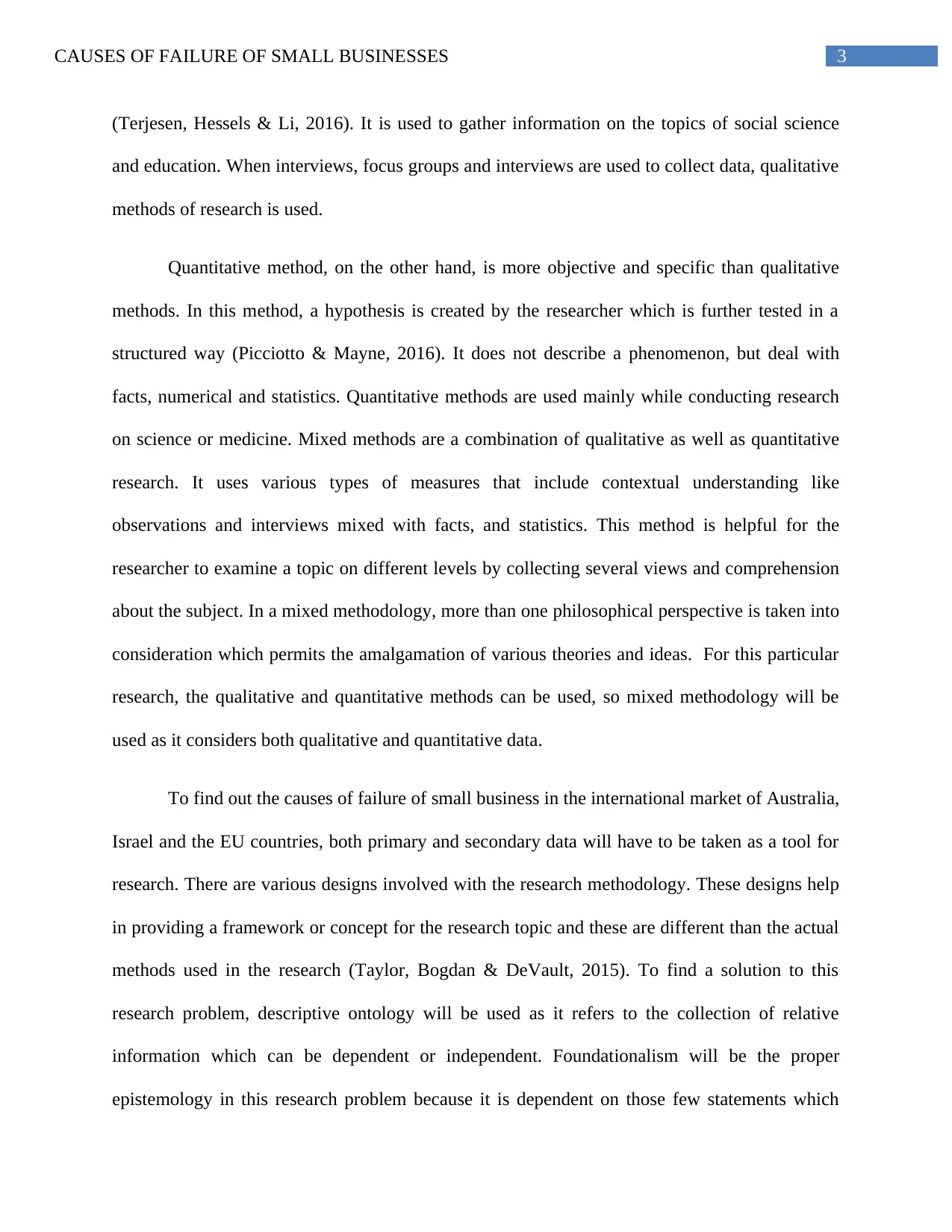
3CAUSES OF FAILURE OF SMALL BUSINESSES
(Terjesen, Hessels & Li, 2016). It is used to gather information on the topics of social science
and education. When interviews, focus groups and interviews are used to collect data, qualitative
methods of research is used.
Quantitative method, on the other hand, is more objective and specific than qualitative
methods. In this method, a hypothesis is created by the researcher which is further tested in a
structured way (Picciotto & Mayne, 2016). It does not describe a phenomenon, but deal with
facts, numerical and statistics. Quantitative methods are used mainly while conducting research
on science or medicine. Mixed methods are a combination of qualitative as well as quantitative
research. It uses various types of measures that include contextual understanding like
observations and interviews mixed with facts, and statistics. This method is helpful for the
researcher to examine a topic on different levels by collecting several views and comprehension
about the subject. In a mixed methodology, more than one philosophical perspective is taken into
consideration which permits the amalgamation of various theories and ideas. For this particular
research, the qualitative and quantitative methods can be used, so mixed methodology will be
used as it considers both qualitative and quantitative data.
To find out the causes of failure of small business in the international market of Australia,
Israel and the EU countries, both primary and secondary data will have to be taken as a tool for
research. There are various designs involved with the research methodology. These designs help
in providing a framework or concept for the research topic and these are different than the actual
methods used in the research (Taylor, Bogdan & DeVault, 2015). To find a solution to this
research problem, descriptive ontology will be used as it refers to the collection of relative
information which can be dependent or independent. Foundationalism will be the proper
epistemology in this research problem because it is dependent on those few statements which
(Terjesen, Hessels & Li, 2016). It is used to gather information on the topics of social science
and education. When interviews, focus groups and interviews are used to collect data, qualitative
methods of research is used.
Quantitative method, on the other hand, is more objective and specific than qualitative
methods. In this method, a hypothesis is created by the researcher which is further tested in a
structured way (Picciotto & Mayne, 2016). It does not describe a phenomenon, but deal with
facts, numerical and statistics. Quantitative methods are used mainly while conducting research
on science or medicine. Mixed methods are a combination of qualitative as well as quantitative
research. It uses various types of measures that include contextual understanding like
observations and interviews mixed with facts, and statistics. This method is helpful for the
researcher to examine a topic on different levels by collecting several views and comprehension
about the subject. In a mixed methodology, more than one philosophical perspective is taken into
consideration which permits the amalgamation of various theories and ideas. For this particular
research, the qualitative and quantitative methods can be used, so mixed methodology will be
used as it considers both qualitative and quantitative data.
To find out the causes of failure of small business in the international market of Australia,
Israel and the EU countries, both primary and secondary data will have to be taken as a tool for
research. There are various designs involved with the research methodology. These designs help
in providing a framework or concept for the research topic and these are different than the actual
methods used in the research (Taylor, Bogdan & DeVault, 2015). To find a solution to this
research problem, descriptive ontology will be used as it refers to the collection of relative
information which can be dependent or independent. Foundationalism will be the proper
epistemology in this research problem because it is dependent on those few statements which
Paraphrase This Document
Need a fresh take? Get an instant paraphrase of this document with our AI Paraphraser
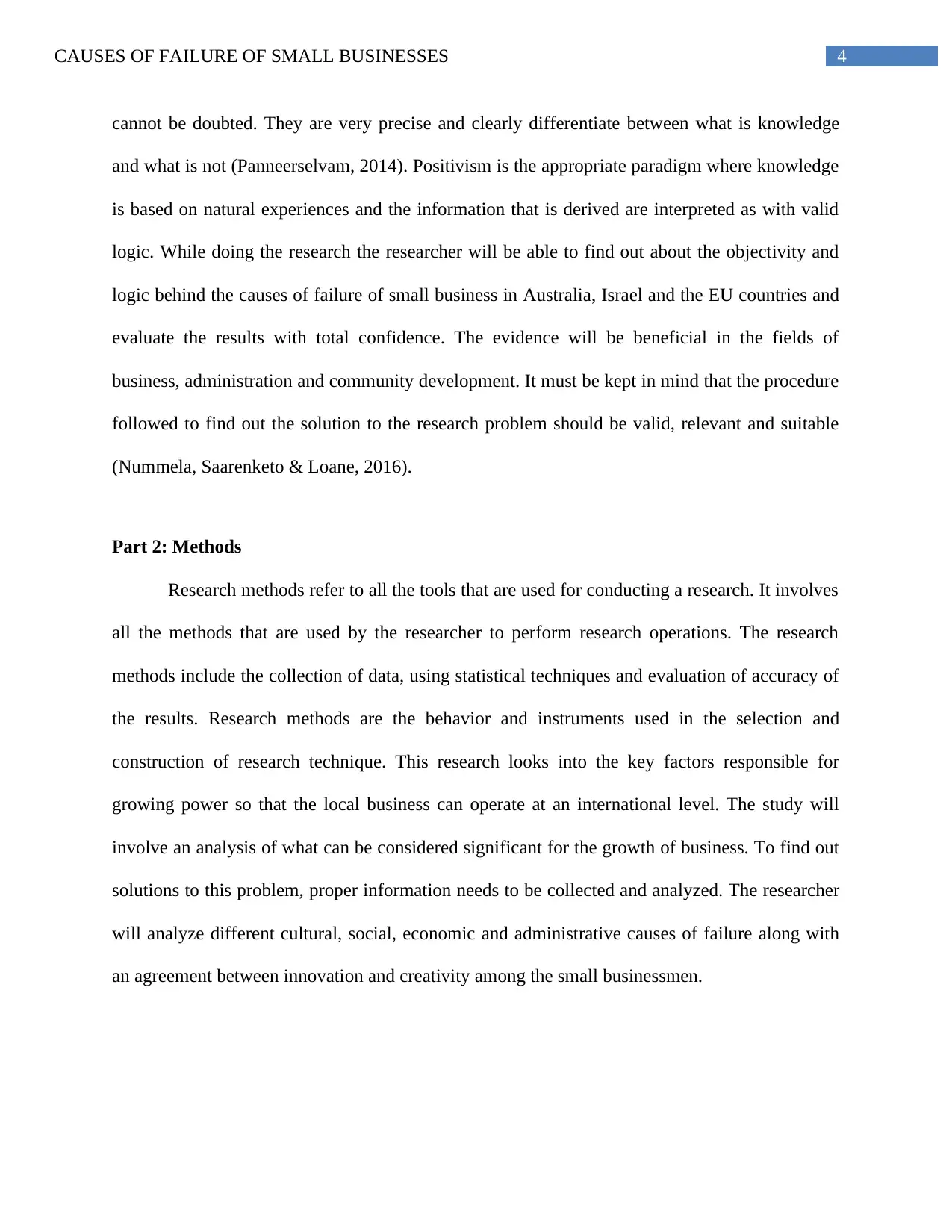
4CAUSES OF FAILURE OF SMALL BUSINESSES
cannot be doubted. They are very precise and clearly differentiate between what is knowledge
and what is not (Panneerselvam, 2014). Positivism is the appropriate paradigm where knowledge
is based on natural experiences and the information that is derived are interpreted as with valid
logic. While doing the research the researcher will be able to find out about the objectivity and
logic behind the causes of failure of small business in Australia, Israel and the EU countries and
evaluate the results with total confidence. The evidence will be beneficial in the fields of
business, administration and community development. It must be kept in mind that the procedure
followed to find out the solution to the research problem should be valid, relevant and suitable
(Nummela, Saarenketo & Loane, 2016).
Part 2: Methods
Research methods refer to all the tools that are used for conducting a research. It involves
all the methods that are used by the researcher to perform research operations. The research
methods include the collection of data, using statistical techniques and evaluation of accuracy of
the results. Research methods are the behavior and instruments used in the selection and
construction of research technique. This research looks into the key factors responsible for
growing power so that the local business can operate at an international level. The study will
involve an analysis of what can be considered significant for the growth of business. To find out
solutions to this problem, proper information needs to be collected and analyzed. The researcher
will analyze different cultural, social, economic and administrative causes of failure along with
an agreement between innovation and creativity among the small businessmen.
cannot be doubted. They are very precise and clearly differentiate between what is knowledge
and what is not (Panneerselvam, 2014). Positivism is the appropriate paradigm where knowledge
is based on natural experiences and the information that is derived are interpreted as with valid
logic. While doing the research the researcher will be able to find out about the objectivity and
logic behind the causes of failure of small business in Australia, Israel and the EU countries and
evaluate the results with total confidence. The evidence will be beneficial in the fields of
business, administration and community development. It must be kept in mind that the procedure
followed to find out the solution to the research problem should be valid, relevant and suitable
(Nummela, Saarenketo & Loane, 2016).
Part 2: Methods
Research methods refer to all the tools that are used for conducting a research. It involves
all the methods that are used by the researcher to perform research operations. The research
methods include the collection of data, using statistical techniques and evaluation of accuracy of
the results. Research methods are the behavior and instruments used in the selection and
construction of research technique. This research looks into the key factors responsible for
growing power so that the local business can operate at an international level. The study will
involve an analysis of what can be considered significant for the growth of business. To find out
solutions to this problem, proper information needs to be collected and analyzed. The researcher
will analyze different cultural, social, economic and administrative causes of failure along with
an agreement between innovation and creativity among the small businessmen.
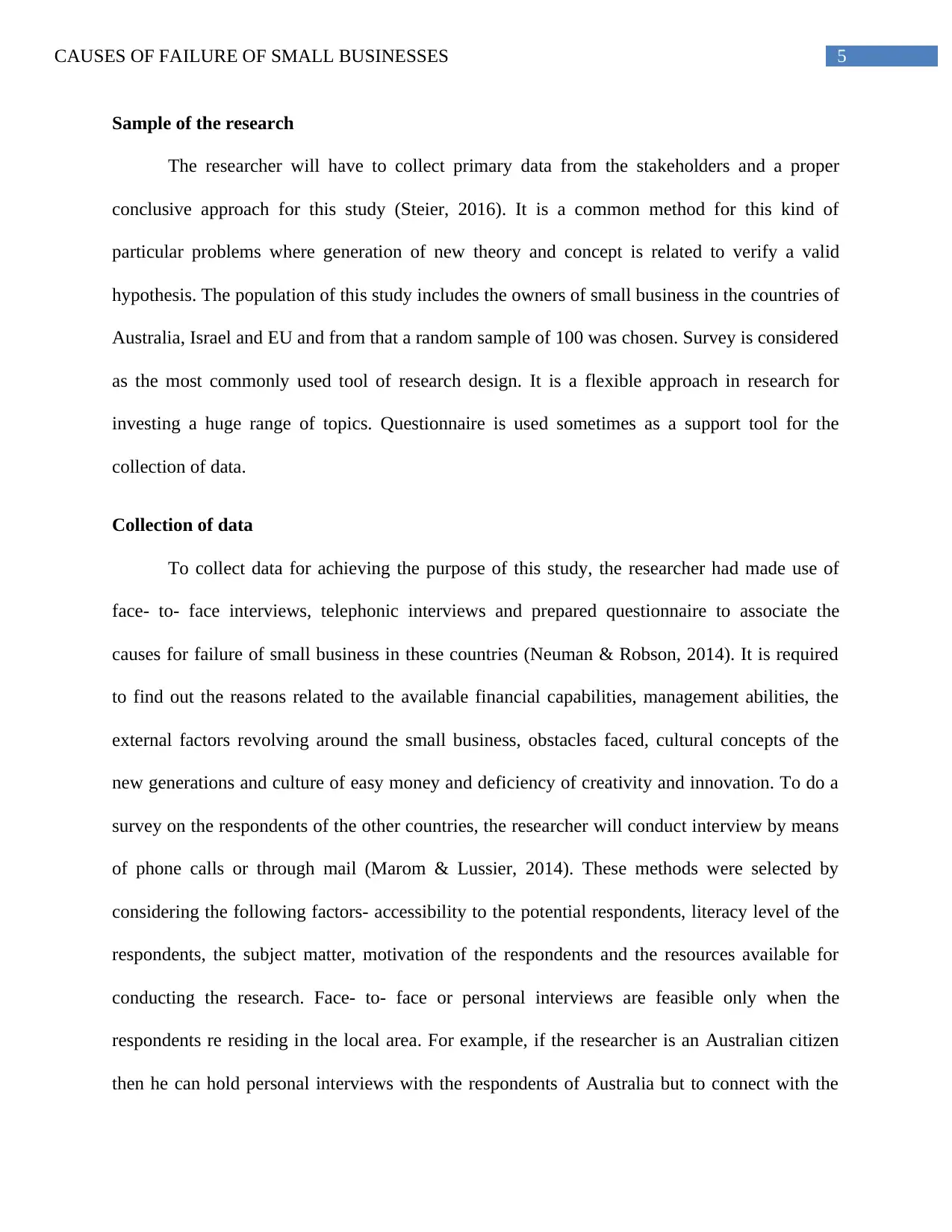
5CAUSES OF FAILURE OF SMALL BUSINESSES
Sample of the research
The researcher will have to collect primary data from the stakeholders and a proper
conclusive approach for this study (Steier, 2016). It is a common method for this kind of
particular problems where generation of new theory and concept is related to verify a valid
hypothesis. The population of this study includes the owners of small business in the countries of
Australia, Israel and EU and from that a random sample of 100 was chosen. Survey is considered
as the most commonly used tool of research design. It is a flexible approach in research for
investing a huge range of topics. Questionnaire is used sometimes as a support tool for the
collection of data.
Collection of data
To collect data for achieving the purpose of this study, the researcher had made use of
face- to- face interviews, telephonic interviews and prepared questionnaire to associate the
causes for failure of small business in these countries (Neuman & Robson, 2014). It is required
to find out the reasons related to the available financial capabilities, management abilities, the
external factors revolving around the small business, obstacles faced, cultural concepts of the
new generations and culture of easy money and deficiency of creativity and innovation. To do a
survey on the respondents of the other countries, the researcher will conduct interview by means
of phone calls or through mail (Marom & Lussier, 2014). These methods were selected by
considering the following factors- accessibility to the potential respondents, literacy level of the
respondents, the subject matter, motivation of the respondents and the resources available for
conducting the research. Face- to- face or personal interviews are feasible only when the
respondents re residing in the local area. For example, if the researcher is an Australian citizen
then he can hold personal interviews with the respondents of Australia but to connect with the
Sample of the research
The researcher will have to collect primary data from the stakeholders and a proper
conclusive approach for this study (Steier, 2016). It is a common method for this kind of
particular problems where generation of new theory and concept is related to verify a valid
hypothesis. The population of this study includes the owners of small business in the countries of
Australia, Israel and EU and from that a random sample of 100 was chosen. Survey is considered
as the most commonly used tool of research design. It is a flexible approach in research for
investing a huge range of topics. Questionnaire is used sometimes as a support tool for the
collection of data.
Collection of data
To collect data for achieving the purpose of this study, the researcher had made use of
face- to- face interviews, telephonic interviews and prepared questionnaire to associate the
causes for failure of small business in these countries (Neuman & Robson, 2014). It is required
to find out the reasons related to the available financial capabilities, management abilities, the
external factors revolving around the small business, obstacles faced, cultural concepts of the
new generations and culture of easy money and deficiency of creativity and innovation. To do a
survey on the respondents of the other countries, the researcher will conduct interview by means
of phone calls or through mail (Marom & Lussier, 2014). These methods were selected by
considering the following factors- accessibility to the potential respondents, literacy level of the
respondents, the subject matter, motivation of the respondents and the resources available for
conducting the research. Face- to- face or personal interviews are feasible only when the
respondents re residing in the local area. For example, if the researcher is an Australian citizen
then he can hold personal interviews with the respondents of Australia but to connect with the
⊘ This is a preview!⊘
Do you want full access?
Subscribe today to unlock all pages.

Trusted by 1+ million students worldwide
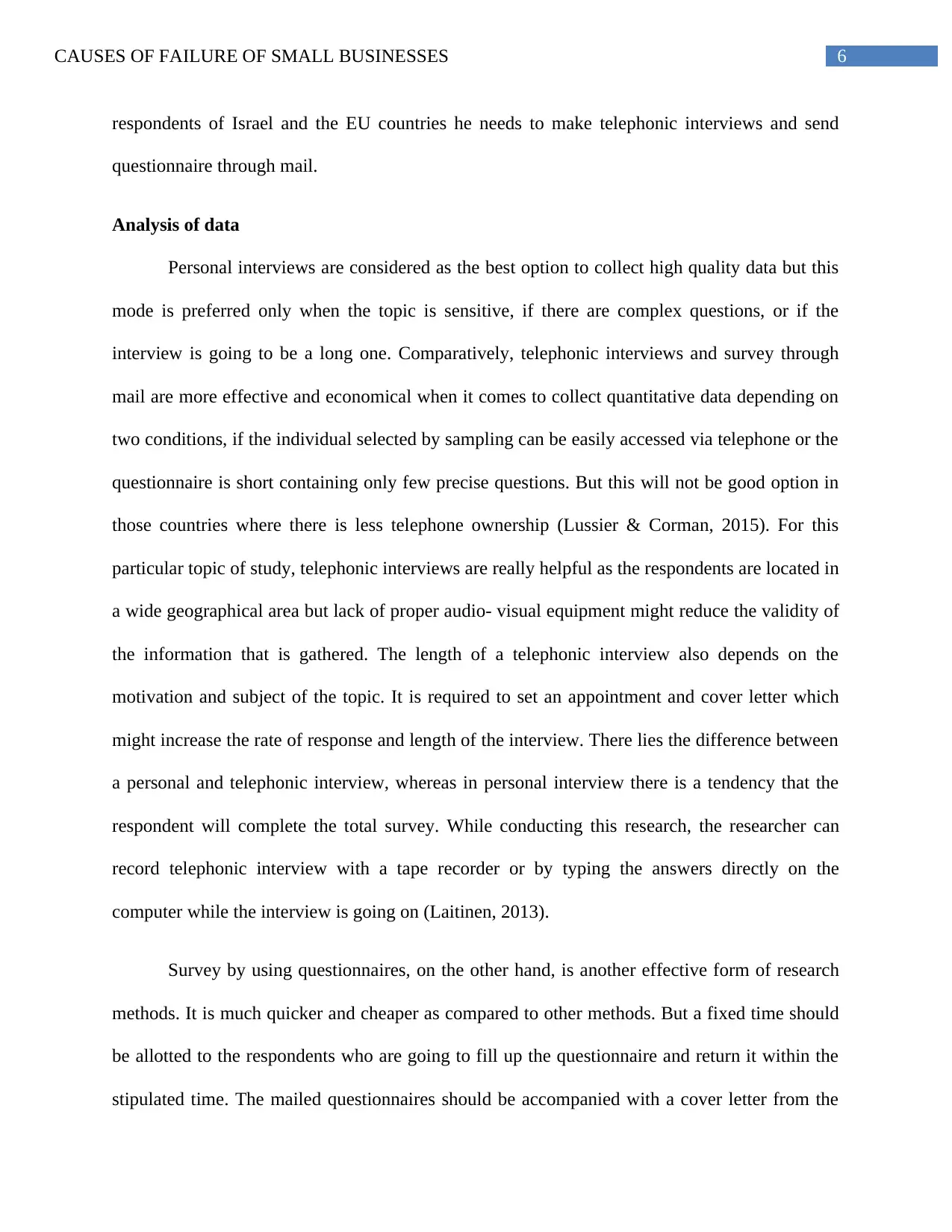
6CAUSES OF FAILURE OF SMALL BUSINESSES
respondents of Israel and the EU countries he needs to make telephonic interviews and send
questionnaire through mail.
Analysis of data
Personal interviews are considered as the best option to collect high quality data but this
mode is preferred only when the topic is sensitive, if there are complex questions, or if the
interview is going to be a long one. Comparatively, telephonic interviews and survey through
mail are more effective and economical when it comes to collect quantitative data depending on
two conditions, if the individual selected by sampling can be easily accessed via telephone or the
questionnaire is short containing only few precise questions. But this will not be good option in
those countries where there is less telephone ownership (Lussier & Corman, 2015). For this
particular topic of study, telephonic interviews are really helpful as the respondents are located in
a wide geographical area but lack of proper audio- visual equipment might reduce the validity of
the information that is gathered. The length of a telephonic interview also depends on the
motivation and subject of the topic. It is required to set an appointment and cover letter which
might increase the rate of response and length of the interview. There lies the difference between
a personal and telephonic interview, whereas in personal interview there is a tendency that the
respondent will complete the total survey. While conducting this research, the researcher can
record telephonic interview with a tape recorder or by typing the answers directly on the
computer while the interview is going on (Laitinen, 2013).
Survey by using questionnaires, on the other hand, is another effective form of research
methods. It is much quicker and cheaper as compared to other methods. But a fixed time should
be allotted to the respondents who are going to fill up the questionnaire and return it within the
stipulated time. The mailed questionnaires should be accompanied with a cover letter from the
respondents of Israel and the EU countries he needs to make telephonic interviews and send
questionnaire through mail.
Analysis of data
Personal interviews are considered as the best option to collect high quality data but this
mode is preferred only when the topic is sensitive, if there are complex questions, or if the
interview is going to be a long one. Comparatively, telephonic interviews and survey through
mail are more effective and economical when it comes to collect quantitative data depending on
two conditions, if the individual selected by sampling can be easily accessed via telephone or the
questionnaire is short containing only few precise questions. But this will not be good option in
those countries where there is less telephone ownership (Lussier & Corman, 2015). For this
particular topic of study, telephonic interviews are really helpful as the respondents are located in
a wide geographical area but lack of proper audio- visual equipment might reduce the validity of
the information that is gathered. The length of a telephonic interview also depends on the
motivation and subject of the topic. It is required to set an appointment and cover letter which
might increase the rate of response and length of the interview. There lies the difference between
a personal and telephonic interview, whereas in personal interview there is a tendency that the
respondent will complete the total survey. While conducting this research, the researcher can
record telephonic interview with a tape recorder or by typing the answers directly on the
computer while the interview is going on (Laitinen, 2013).
Survey by using questionnaires, on the other hand, is another effective form of research
methods. It is much quicker and cheaper as compared to other methods. But a fixed time should
be allotted to the respondents who are going to fill up the questionnaire and return it within the
stipulated time. The mailed questionnaires should be accompanied with a cover letter from the
Paraphrase This Document
Need a fresh take? Get an instant paraphrase of this document with our AI Paraphraser
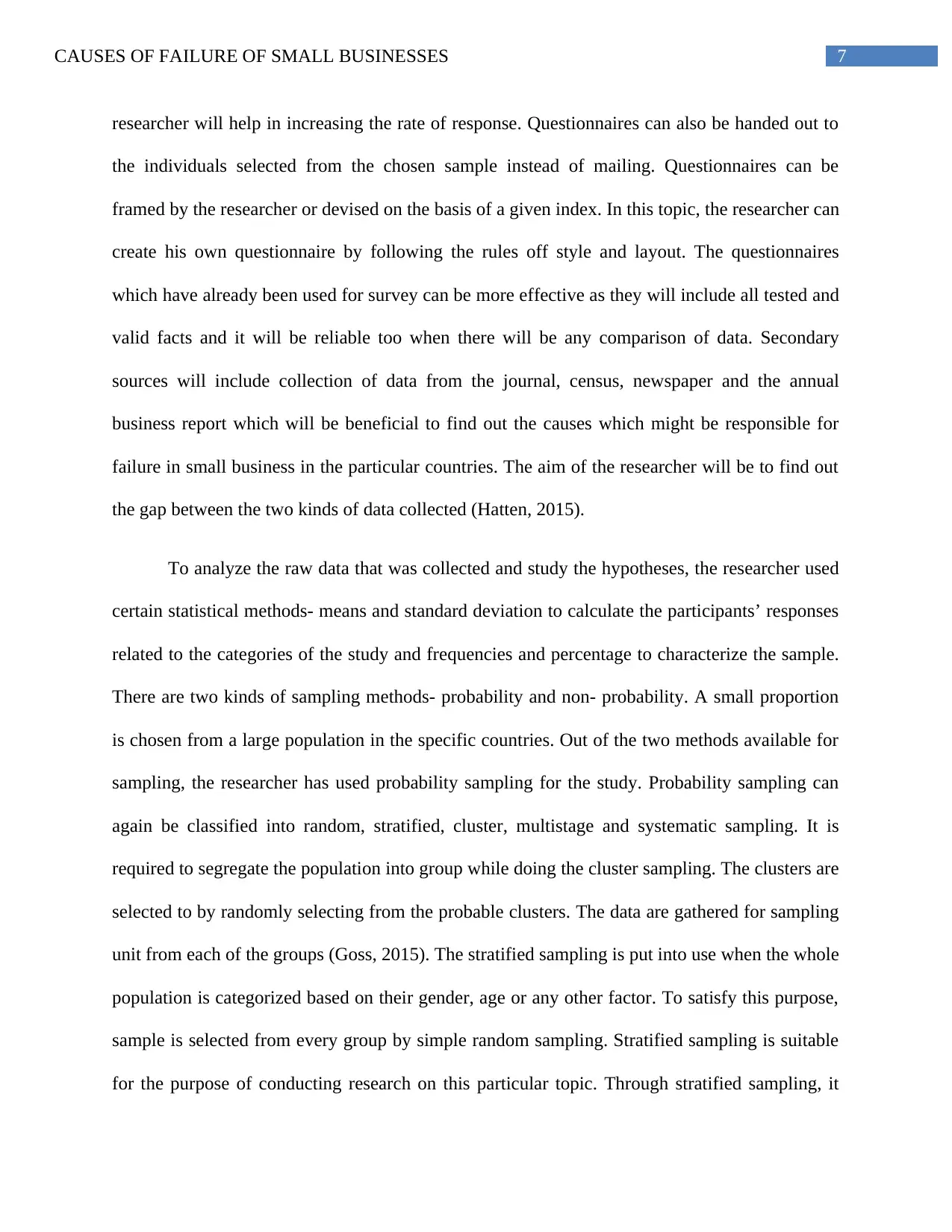
7CAUSES OF FAILURE OF SMALL BUSINESSES
researcher will help in increasing the rate of response. Questionnaires can also be handed out to
the individuals selected from the chosen sample instead of mailing. Questionnaires can be
framed by the researcher or devised on the basis of a given index. In this topic, the researcher can
create his own questionnaire by following the rules off style and layout. The questionnaires
which have already been used for survey can be more effective as they will include all tested and
valid facts and it will be reliable too when there will be any comparison of data. Secondary
sources will include collection of data from the journal, census, newspaper and the annual
business report which will be beneficial to find out the causes which might be responsible for
failure in small business in the particular countries. The aim of the researcher will be to find out
the gap between the two kinds of data collected (Hatten, 2015).
To analyze the raw data that was collected and study the hypotheses, the researcher used
certain statistical methods- means and standard deviation to calculate the participants’ responses
related to the categories of the study and frequencies and percentage to characterize the sample.
There are two kinds of sampling methods- probability and non- probability. A small proportion
is chosen from a large population in the specific countries. Out of the two methods available for
sampling, the researcher has used probability sampling for the study. Probability sampling can
again be classified into random, stratified, cluster, multistage and systematic sampling. It is
required to segregate the population into group while doing the cluster sampling. The clusters are
selected to by randomly selecting from the probable clusters. The data are gathered for sampling
unit from each of the groups (Goss, 2015). The stratified sampling is put into use when the whole
population is categorized based on their gender, age or any other factor. To satisfy this purpose,
sample is selected from every group by simple random sampling. Stratified sampling is suitable
for the purpose of conducting research on this particular topic. Through stratified sampling, it
researcher will help in increasing the rate of response. Questionnaires can also be handed out to
the individuals selected from the chosen sample instead of mailing. Questionnaires can be
framed by the researcher or devised on the basis of a given index. In this topic, the researcher can
create his own questionnaire by following the rules off style and layout. The questionnaires
which have already been used for survey can be more effective as they will include all tested and
valid facts and it will be reliable too when there will be any comparison of data. Secondary
sources will include collection of data from the journal, census, newspaper and the annual
business report which will be beneficial to find out the causes which might be responsible for
failure in small business in the particular countries. The aim of the researcher will be to find out
the gap between the two kinds of data collected (Hatten, 2015).
To analyze the raw data that was collected and study the hypotheses, the researcher used
certain statistical methods- means and standard deviation to calculate the participants’ responses
related to the categories of the study and frequencies and percentage to characterize the sample.
There are two kinds of sampling methods- probability and non- probability. A small proportion
is chosen from a large population in the specific countries. Out of the two methods available for
sampling, the researcher has used probability sampling for the study. Probability sampling can
again be classified into random, stratified, cluster, multistage and systematic sampling. It is
required to segregate the population into group while doing the cluster sampling. The clusters are
selected to by randomly selecting from the probable clusters. The data are gathered for sampling
unit from each of the groups (Goss, 2015). The stratified sampling is put into use when the whole
population is categorized based on their gender, age or any other factor. To satisfy this purpose,
sample is selected from every group by simple random sampling. Stratified sampling is suitable
for the purpose of conducting research on this particular topic. Through stratified sampling, it
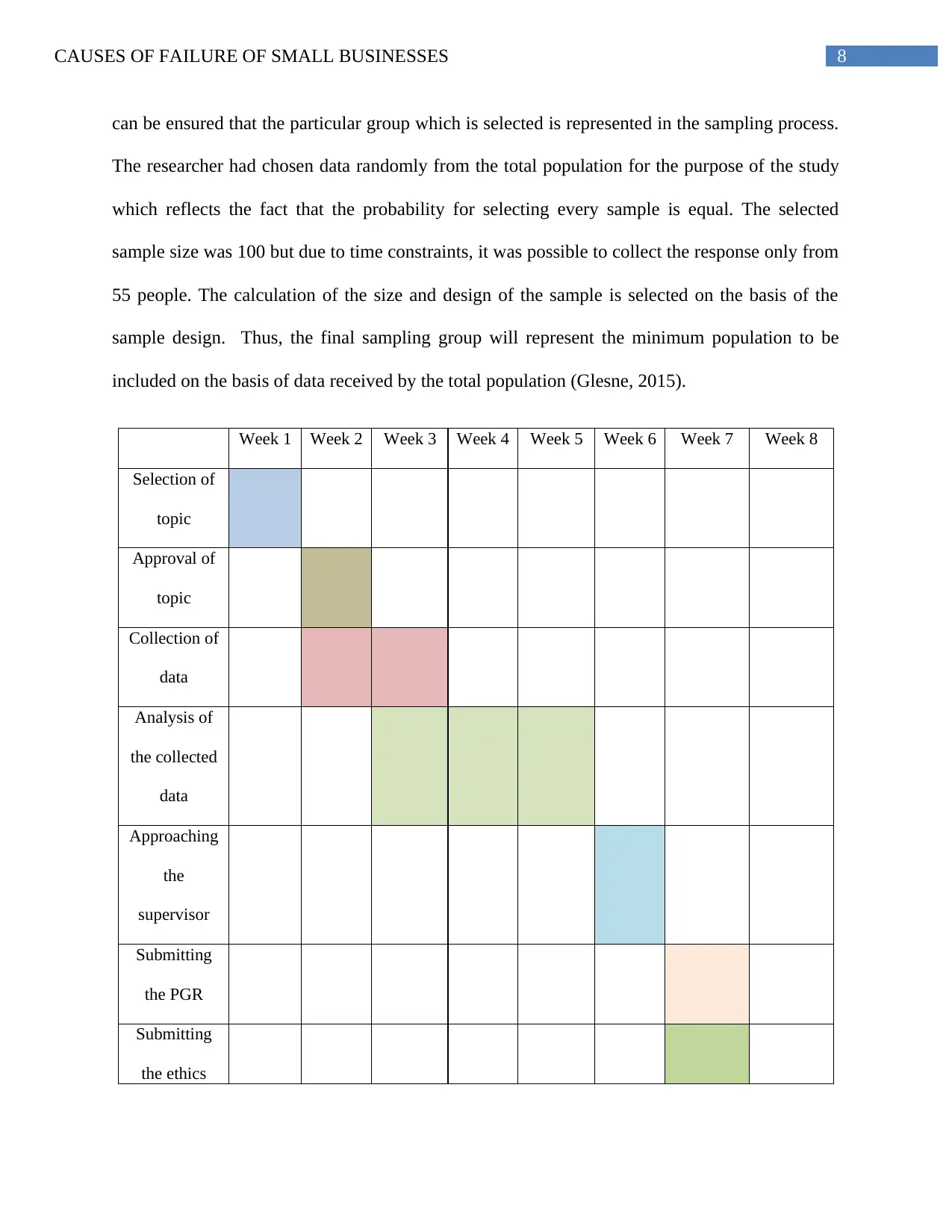
8CAUSES OF FAILURE OF SMALL BUSINESSES
can be ensured that the particular group which is selected is represented in the sampling process.
The researcher had chosen data randomly from the total population for the purpose of the study
which reflects the fact that the probability for selecting every sample is equal. The selected
sample size was 100 but due to time constraints, it was possible to collect the response only from
55 people. The calculation of the size and design of the sample is selected on the basis of the
sample design. Thus, the final sampling group will represent the minimum population to be
included on the basis of data received by the total population (Glesne, 2015).
Week 1 Week 2 Week 3 Week 4 Week 5 Week 6 Week 7 Week 8
Selection of
topic
Approval of
topic
Collection of
data
Analysis of
the collected
data
Approaching
the
supervisor
Submitting
the PGR
Submitting
the ethics
can be ensured that the particular group which is selected is represented in the sampling process.
The researcher had chosen data randomly from the total population for the purpose of the study
which reflects the fact that the probability for selecting every sample is equal. The selected
sample size was 100 but due to time constraints, it was possible to collect the response only from
55 people. The calculation of the size and design of the sample is selected on the basis of the
sample design. Thus, the final sampling group will represent the minimum population to be
included on the basis of data received by the total population (Glesne, 2015).
Week 1 Week 2 Week 3 Week 4 Week 5 Week 6 Week 7 Week 8
Selection of
topic
Approval of
topic
Collection of
data
Analysis of
the collected
data
Approaching
the
supervisor
Submitting
the PGR
Submitting
the ethics
⊘ This is a preview!⊘
Do you want full access?
Subscribe today to unlock all pages.

Trusted by 1+ million students worldwide
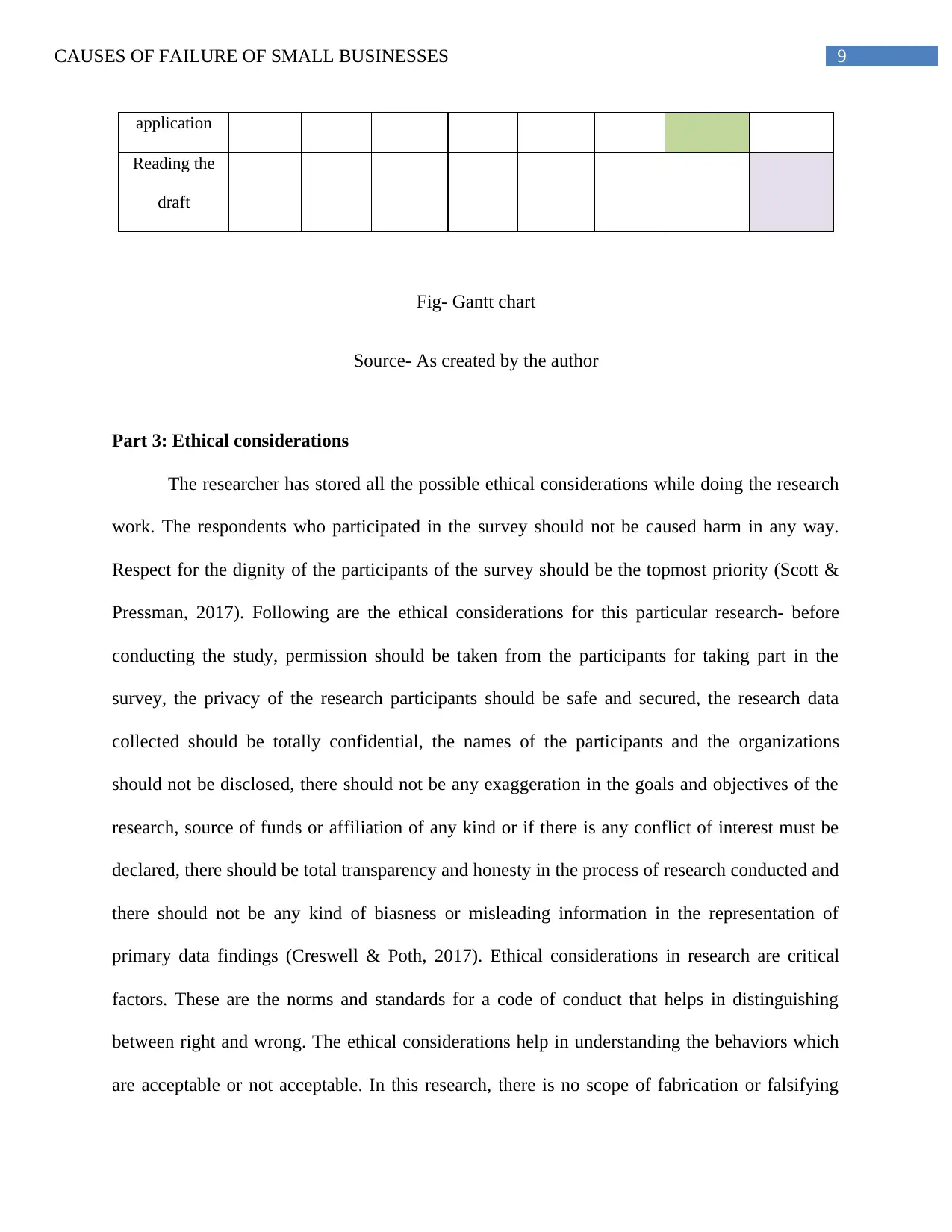
9CAUSES OF FAILURE OF SMALL BUSINESSES
application
Reading the
draft
Fig- Gantt chart
Source- As created by the author
Part 3: Ethical considerations
The researcher has stored all the possible ethical considerations while doing the research
work. The respondents who participated in the survey should not be caused harm in any way.
Respect for the dignity of the participants of the survey should be the topmost priority (Scott &
Pressman, 2017). Following are the ethical considerations for this particular research- before
conducting the study, permission should be taken from the participants for taking part in the
survey, the privacy of the research participants should be safe and secured, the research data
collected should be totally confidential, the names of the participants and the organizations
should not be disclosed, there should not be any exaggeration in the goals and objectives of the
research, source of funds or affiliation of any kind or if there is any conflict of interest must be
declared, there should be total transparency and honesty in the process of research conducted and
there should not be any kind of biasness or misleading information in the representation of
primary data findings (Creswell & Poth, 2017). Ethical considerations in research are critical
factors. These are the norms and standards for a code of conduct that helps in distinguishing
between right and wrong. The ethical considerations help in understanding the behaviors which
are acceptable or not acceptable. In this research, there is no scope of fabrication or falsifying
application
Reading the
draft
Fig- Gantt chart
Source- As created by the author
Part 3: Ethical considerations
The researcher has stored all the possible ethical considerations while doing the research
work. The respondents who participated in the survey should not be caused harm in any way.
Respect for the dignity of the participants of the survey should be the topmost priority (Scott &
Pressman, 2017). Following are the ethical considerations for this particular research- before
conducting the study, permission should be taken from the participants for taking part in the
survey, the privacy of the research participants should be safe and secured, the research data
collected should be totally confidential, the names of the participants and the organizations
should not be disclosed, there should not be any exaggeration in the goals and objectives of the
research, source of funds or affiliation of any kind or if there is any conflict of interest must be
declared, there should be total transparency and honesty in the process of research conducted and
there should not be any kind of biasness or misleading information in the representation of
primary data findings (Creswell & Poth, 2017). Ethical considerations in research are critical
factors. These are the norms and standards for a code of conduct that helps in distinguishing
between right and wrong. The ethical considerations help in understanding the behaviors which
are acceptable or not acceptable. In this research, there is no scope of fabrication or falsifying
Paraphrase This Document
Need a fresh take? Get an instant paraphrase of this document with our AI Paraphraser
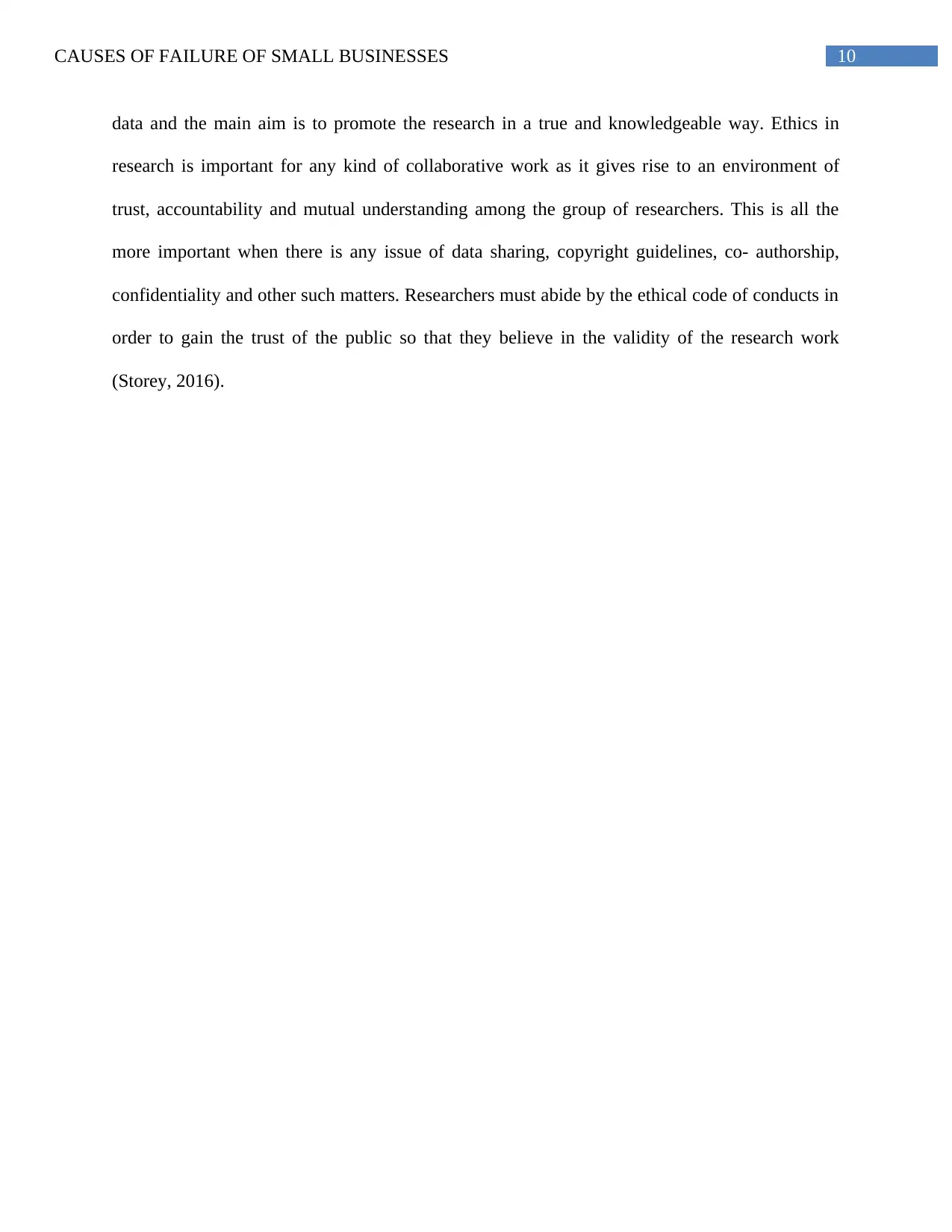
10CAUSES OF FAILURE OF SMALL BUSINESSES
data and the main aim is to promote the research in a true and knowledgeable way. Ethics in
research is important for any kind of collaborative work as it gives rise to an environment of
trust, accountability and mutual understanding among the group of researchers. This is all the
more important when there is any issue of data sharing, copyright guidelines, co- authorship,
confidentiality and other such matters. Researchers must abide by the ethical code of conducts in
order to gain the trust of the public so that they believe in the validity of the research work
(Storey, 2016).
data and the main aim is to promote the research in a true and knowledgeable way. Ethics in
research is important for any kind of collaborative work as it gives rise to an environment of
trust, accountability and mutual understanding among the group of researchers. This is all the
more important when there is any issue of data sharing, copyright guidelines, co- authorship,
confidentiality and other such matters. Researchers must abide by the ethical code of conducts in
order to gain the trust of the public so that they believe in the validity of the research work
(Storey, 2016).
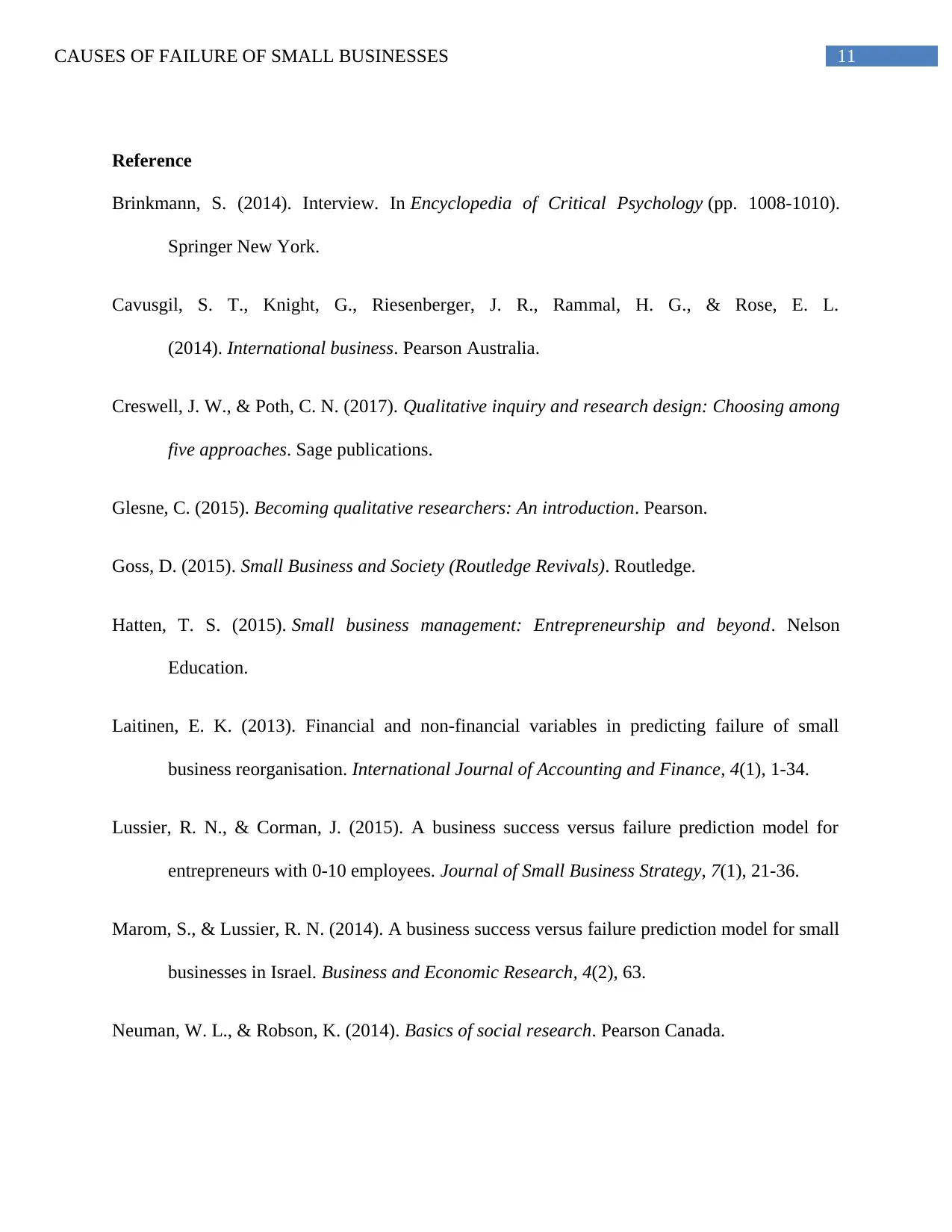
11CAUSES OF FAILURE OF SMALL BUSINESSES
Reference
Brinkmann, S. (2014). Interview. In Encyclopedia of Critical Psychology (pp. 1008-1010).
Springer New York.
Cavusgil, S. T., Knight, G., Riesenberger, J. R., Rammal, H. G., & Rose, E. L.
(2014). International business. Pearson Australia.
Creswell, J. W., & Poth, C. N. (2017). Qualitative inquiry and research design: Choosing among
five approaches. Sage publications.
Glesne, C. (2015). Becoming qualitative researchers: An introduction. Pearson.
Goss, D. (2015). Small Business and Society (Routledge Revivals). Routledge.
Hatten, T. S. (2015). Small business management: Entrepreneurship and beyond. Nelson
Education.
Laitinen, E. K. (2013). Financial and non-financial variables in predicting failure of small
business reorganisation. International Journal of Accounting and Finance, 4(1), 1-34.
Lussier, R. N., & Corman, J. (2015). A business success versus failure prediction model for
entrepreneurs with 0-10 employees. Journal of Small Business Strategy, 7(1), 21-36.
Marom, S., & Lussier, R. N. (2014). A business success versus failure prediction model for small
businesses in Israel. Business and Economic Research, 4(2), 63.
Neuman, W. L., & Robson, K. (2014). Basics of social research. Pearson Canada.
Reference
Brinkmann, S. (2014). Interview. In Encyclopedia of Critical Psychology (pp. 1008-1010).
Springer New York.
Cavusgil, S. T., Knight, G., Riesenberger, J. R., Rammal, H. G., & Rose, E. L.
(2014). International business. Pearson Australia.
Creswell, J. W., & Poth, C. N. (2017). Qualitative inquiry and research design: Choosing among
five approaches. Sage publications.
Glesne, C. (2015). Becoming qualitative researchers: An introduction. Pearson.
Goss, D. (2015). Small Business and Society (Routledge Revivals). Routledge.
Hatten, T. S. (2015). Small business management: Entrepreneurship and beyond. Nelson
Education.
Laitinen, E. K. (2013). Financial and non-financial variables in predicting failure of small
business reorganisation. International Journal of Accounting and Finance, 4(1), 1-34.
Lussier, R. N., & Corman, J. (2015). A business success versus failure prediction model for
entrepreneurs with 0-10 employees. Journal of Small Business Strategy, 7(1), 21-36.
Marom, S., & Lussier, R. N. (2014). A business success versus failure prediction model for small
businesses in Israel. Business and Economic Research, 4(2), 63.
Neuman, W. L., & Robson, K. (2014). Basics of social research. Pearson Canada.
⊘ This is a preview!⊘
Do you want full access?
Subscribe today to unlock all pages.

Trusted by 1+ million students worldwide
1 out of 14
Related Documents
Your All-in-One AI-Powered Toolkit for Academic Success.
+13062052269
info@desklib.com
Available 24*7 on WhatsApp / Email
![[object Object]](/_next/static/media/star-bottom.7253800d.svg)
Unlock your academic potential
Copyright © 2020–2025 A2Z Services. All Rights Reserved. Developed and managed by ZUCOL.





